Emissions and Absorption of CO2 in China’s Cold Regions
Abstract
:1. Introduction
2. Methodology
2.1. Target Region
2.2. City-Level CO2 Emission Inventory
2.2.1. Energy-Related Emission Inventory
2.2.2. Industrial Process
2.2.3. Farmland Ecosystem
2.3. Emission Factors
2.4. CO2 Absorption
2.4.1. Farmland Ecosystem
2.4.2. Living Wood
3. Results and Discussion
3.1. Total CO2 Emissions in Heilongjiang Province
3.1.1. Dominant Energy-Related Sectors
3.1.2. Emissions from Ecological Sectors
3.2. City-Level CO2 Emissions in Heilongjiang
3.3. CO2 Absorption by Ecosystem
3.3.1. CO2 Absorption from the Farmland Ecosystem
3.3.2. CO2 Absorption from Living Wood
3.4. Impacts on Ambient CO2
4. Conclusions
Supplementary Materials
Author Contributions
Funding
Data Availability Statement
Conflicts of Interest
References
- Fang, S.; Luan, T.; Zhang, G.; Wu, Y.; Yu, D. The determination of regional CO2 mole fractions at the Longfengshan WMO/GAW station: A comparison of four data filtering approaches. Atmos. Environ. 2015, 116, 36–43. [Google Scholar] [CrossRef]
- IPCC. AR6 Report: Climate Change 2022: Impacts, Adaptation and Vulnerability. 2022. Available online: https://www.ipcc.ch/report/sixth-assessment-report-working-group-ii/ (accessed on 1 April 2023).
- Shan, Y.; Guan, D.; Zheng, H.; Ou, J.; Li, Y.; Meng, J.; Mi, Z.; Liu, Z.; Zhang, Q. China CO2 emission accounts 1997–2015. Sci. Data 2018, 5, 170201. [Google Scholar] [CrossRef] [PubMed]
- IPCC. Summary for Policymakers. In Climate Change 2014: Mitigation of Climate Change. Contribution of Working Group III to the Fifth Assessment Report of the Intergovernmental Panel on Climate Change; Edenhofer, O., Pichs-Madruga, R., Sokona, Y., Farahani, E., Kadner, S., Seyboth, K., Adler, A., Baum, I., Brunner, S., Eickemeier, P., et al., Eds.; Cambridge University Press: Cambridge, UK; New York, NY, USA, 2014. [Google Scholar]
- Han, P.; Zeng, N.; Oda, T.; Zhang, W.; Lin, X.; Liu, D.; Cai, Q.; Ma, X.; Meng, W.; Wang, G.; et al. A city-level comparison of fossil-fuel and industry processes-induced CO2 emissions over the Beijing-Tianjin-Hebei region from eight emission inventories. Carbon Balance Manag. 2020, 15, 25. [Google Scholar] [CrossRef] [PubMed]
- Yu, W.; Pagani, R.; Huang, L. CO2 emission inventories for Chinese cities in highly urbanized areas compared with European cities. Energy Policy 2012, 47, 298–308. [Google Scholar] [CrossRef]
- Mi, Z.; Zhang, Y.; Guan, D.; Shan, Y.; Liu, Z.; Cong, R.; Yuan, X.-C.; Wei, Y.-M. Consumption-based emission accounting for Chinese cities. Appl. Energy 2016, 184, 1073–1081. [Google Scholar] [CrossRef]
- 2006 IPCC Guidelines for National Greenhouse Gas Inventories. Available online: https://www.ipcc.ch/report/2006-ipcc-guidelines-for-national-greenhouse-gas-inventories/ (accessed on 1 April 2023).
- Cui, C.; Li, S.; Zhao, W.; Liu, B.; Shan, Y.; Guan, D. Energy-Related CO2 Emission Accounts and Datasets for 40 Emerging Economies in 2010–2019. Earth Syst. Sci. Data 2023, 15, 1317–1328. [Google Scholar] [CrossRef]
- Li, M.; Liu, S.; Wu, X.; Sun, Y.; Hou, X.; Zhao, S. Temporal and spatial dynamics in the carbon footprint and its influencing factors of farmland ecosystems in Yunnan Province. Acta Ecol. Sin. 2018, 38, 8822–8834. [Google Scholar]
- Hang, X.; Zhang, J.; Hu, L.; Luo, J.; Ma, L.; Liao, D. Analysis of Carbon Footprints in Farmland Ecosystem of Chongqing City 2006–2015; Chongqing Academy of Agricultural Sciences: Chongqing, China, 2018; p. 401329. [Google Scholar]
- Heilongjiang Province Statistical Yearbook. Available online: http://tjj.hlj.gov.cn/tjj/c106782/common_zfxxgk.shtml (accessed on 1 April 2023).
- National Statistical Yearbook of China. Available online: http://www.stats.gov.cn/tjsj/ndsj (accessed on 1 April 2023).
- Intergovernmental Panel on Climate Change (IPCC). 2019 Refinement to the 2006 IPCC Guidelines for National Greenhouse Gas Inventories; Calvo Buendia, E., Tanabe, K., Kranjc, A., Baasansuren, J., Fukuda, M., Ngarize, S., Osako, A., Pyrozhenko, Y., Shermanau, P., Federici, S., Eds.; IPCC: Geneva, Switzerland, 2019; ISBN 978-4-88788-232-4. [Google Scholar]
- Lei, Y.; Zhang, Q.; Nielsen, C.; He, K. An Inventory of Primary Air Pollutants and CO2 Emissions from Cement Production in China, 1990–2020. Atmos. Environ. 2011, 45, 147–154. [Google Scholar] [CrossRef]
- Liu, Z.; Guan, D.; Wei, W.; Davis, S.J.; Ciais, P.; Bai, J.; Peng, S.; Zhang, Q.; Hubacek, K.; Marland, G.; et al. Reduced carbon emission estimates from fossil fuel combustion and cement production in China. Nature 2015, 524, 335–338. [Google Scholar] [CrossRef]
- Shan, Y.; Huang, Q.; Guan, D.; Hubacek, K. China CO2 emission accounts 2016–2017. Sci. Data 2020, 7, 54. [Google Scholar] [CrossRef]
- Dhakal, S. Urban energy use and carbon emissions from cities in China and policy implications. Energy Policy 2009, 37, 4208–4219. [Google Scholar] [CrossRef]
- Fang, C.; Wang, S.; Li, G. Changing urban forms and carbon dioxide emissions in China: A case study of 30 provincial capital cities. Appl. Energy 2015, 158, 519–531. [Google Scholar] [CrossRef]
- Hou, L. Study on Carbon Emissions of Wheat-Maize Rotation System under Multiple Perspectives—A Case of Shandong Province. Ph.D. Thesis, JLU (Jilin University), Changchun, China, 2022. [Google Scholar]
- Guotong, Q.; Fei, C.; Na, W.; Dandan, Z. Inter-Annual Variation Patterns in the Carbon Footprint of Farmland Ecosystems in Guangdong Province, China. Sci. Rep. 2022, 12, 14134. [Google Scholar] [CrossRef]
- Liu, J.; Zhong, Y.; Jia, X.; Yan, W.; Cao, J.; Shangguan, Z. Wheat Straw Decomposition Patterns and Control Factors Under Nitrogen Fertilization. J. Soil Sci. Plant Nutr. 2021, 21, 3110–3121. [Google Scholar] [CrossRef]
- Lu, F.; Wang, X.; Han, B. Assessment on the availability of nitrogen fertilization in improving carbon sequestration potensial of China’s cropland soil. Chin. J. Appl. Ecol. 2008, 19, 2239–2250. [Google Scholar]
- Wang, Y.; Sun, D.; Li, Z.; Wu, Y. Study on Relationship of Root Morphological Characters and Yeild Formation in Different Sorghum Varietie. Hortic. Seed 2011, 84–86. [Google Scholar]
- Huang, W.; Jiang, W.; Yao, Y.; Song, X.; Wu, G.; Yuan, H.; Ren, C.; Sun, Z.; Wu, J.; Kang, Q. Effects of Low Potassium Stress on Growth and Development of Flax. Plant Fiber Sci. China 2020, 42, 273–282. (In Chinese) [Google Scholar]
- Liebig, M.A.; Gross, J.R.; Kronberg, S.L.; Phillips, R.L. Grazing management contributions to net global warming potential: A long-term evaluation in the Northern Great Plains. J. Environ. Qual. 2010, 39, 799–809. [Google Scholar] [CrossRef] [PubMed]
- Chen, C.; Zhao, T.; Yuan, R.; Kong, Y. A Spatial-Temporal Decomposition Analysis of China’s Carbon Intensity from the Economic Perspective. J. Clean. Prod. 2019, 215, 557–569. [Google Scholar] [CrossRef]
- Tian, Z.; Ma, X.; Liu, R. Interannual Variations of the Carbon Footprint and Carbon Eco-Efficiency in Agro-Ecosystem of Beijing, China. J. Agric. Resour. Environ. 2015, 32, 10. [Google Scholar]
- Ruckstuhl, A.F.; Henne, S.; Reimann, S.; Steinbacher, M.; Vollmer, M.K.; O’Doherty, S.; Buchmann, B.; Hueglin, C. Robust extraction of baseline signal of atmospheric trace species using local regression. Atmos. Meas. Tech. 2012, 5, 2613–2624. [Google Scholar] [CrossRef]
- Saikawa, E.; Kim, H.; Zhong, M.; Avramov, A.; Zhao, Y.; Janssens-Maenhout, G.; Kurokawa, J.; Klimont, Z.; Wagner, F.; Naik, V.; et al. Comparison of emissions inventories of anthropogenic air pollutants and greenhouse gases in China. Atmos. Chem. Phys. 2017, 17, 6393–6421. [Google Scholar] [CrossRef]
- Tao, M.; Cai, Z.; Che, K.; Liu, Y.; Yang, D.; Wu, L.; Wang, P.; Yang, M. Cross-Inventory Uncertainty Analysis of Fossil Fuel CO2 Emissions for Prefecture-Level Cities in Shandong Province. Atmosphere 2022, 13, 1474. [Google Scholar] [CrossRef]
- Yang, E.G.; Kort, E.A.; Wu, D.; Lin, J.C.; Oda, T.; Ye, X.; Lauvaux, T. Using Space-Based Observations and Lagrangian Modeling to Evaluate Urban Carbon Dioxide Emissions in the Middle East. JGR Atmos. 2020, 125, e2019JD031922. [Google Scholar] [CrossRef] [PubMed]
- Ayomikun, B.; Anastasia, I.; Alexey, C. A Comprehensive Review of the Role of CO2 Foam EOR in the Reduction of Carbon Footprint in the Petroleum Industry. Energies 2023, 16, 1167. [Google Scholar] [CrossRef]
- Fetisov, V.; Gonopolsky, A.M.; Zemenkova, M.Y.; Andrey, S.; Davardoost, H.; Mohammadi, A.H.; Riazi, M. On the Integration of CO2 Capture Technologies for an Oil Refinery. Energies 2023, 16, 865. [Google Scholar] [CrossRef]
- Gładysz, P.; Strojny, M.; Bartela, L.; Hacaga, M.; Froehlich, T. Merging Climate Action with Energy Security through CCS—A Multi-Disciplinary Framework for Assessment. Energies 2022, 16, 35. [Google Scholar] [CrossRef]
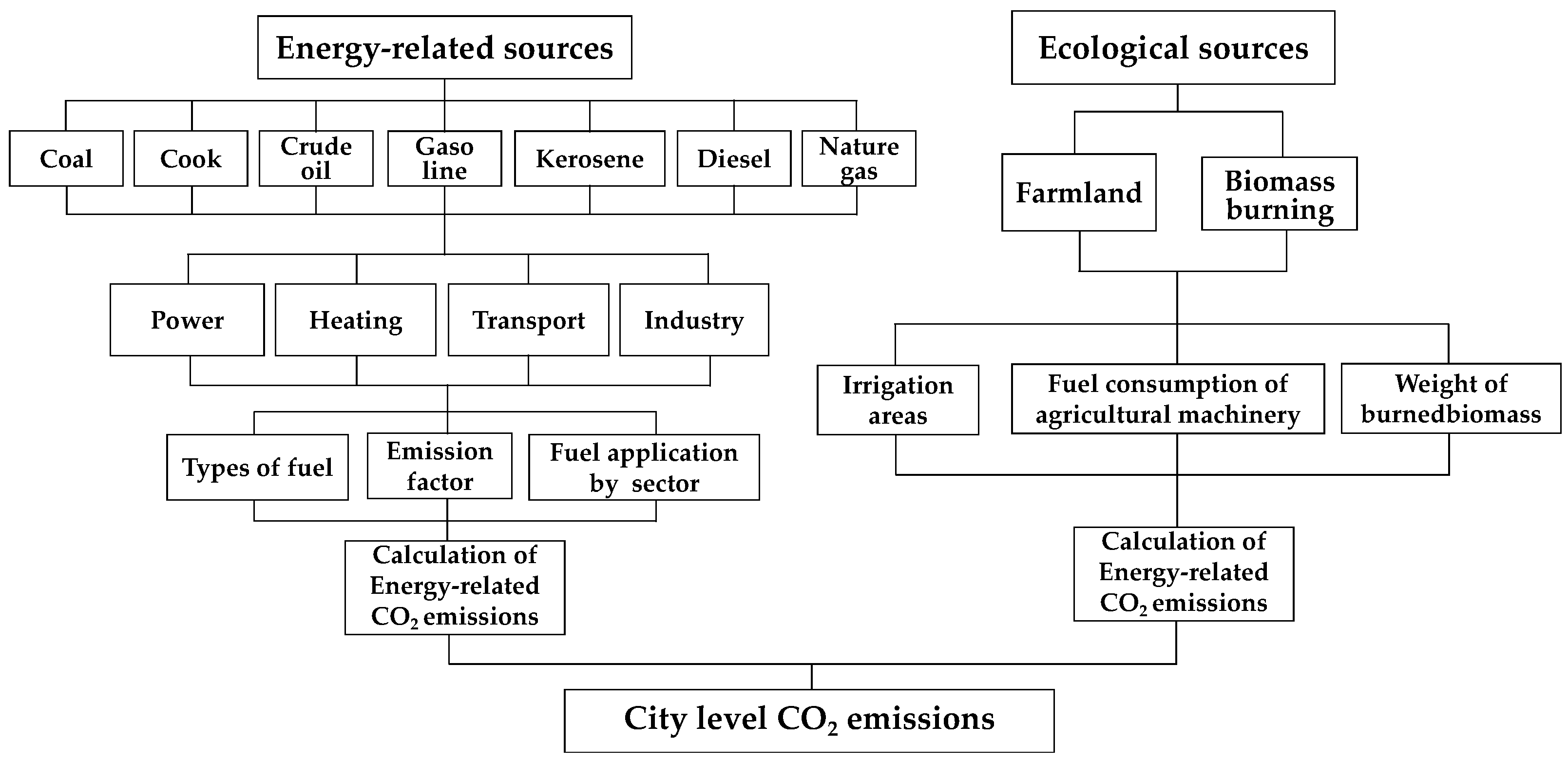
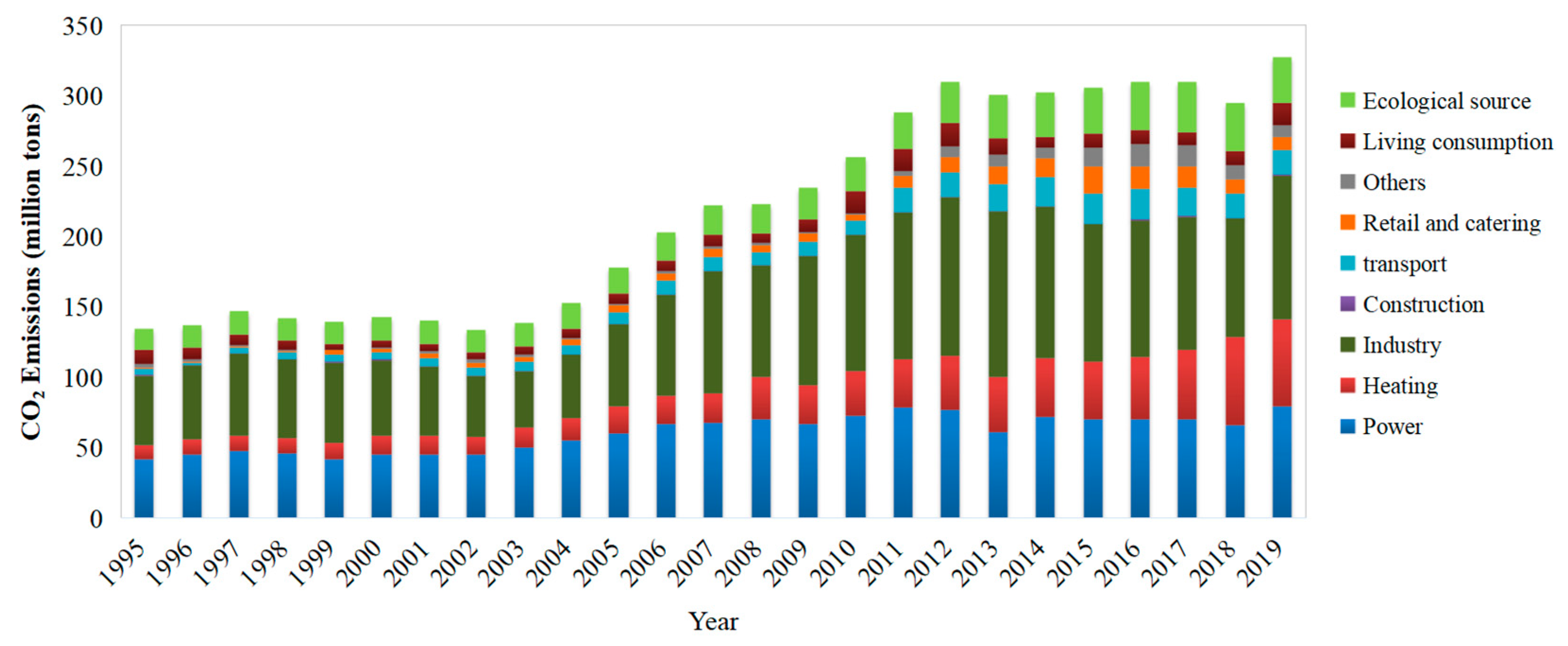
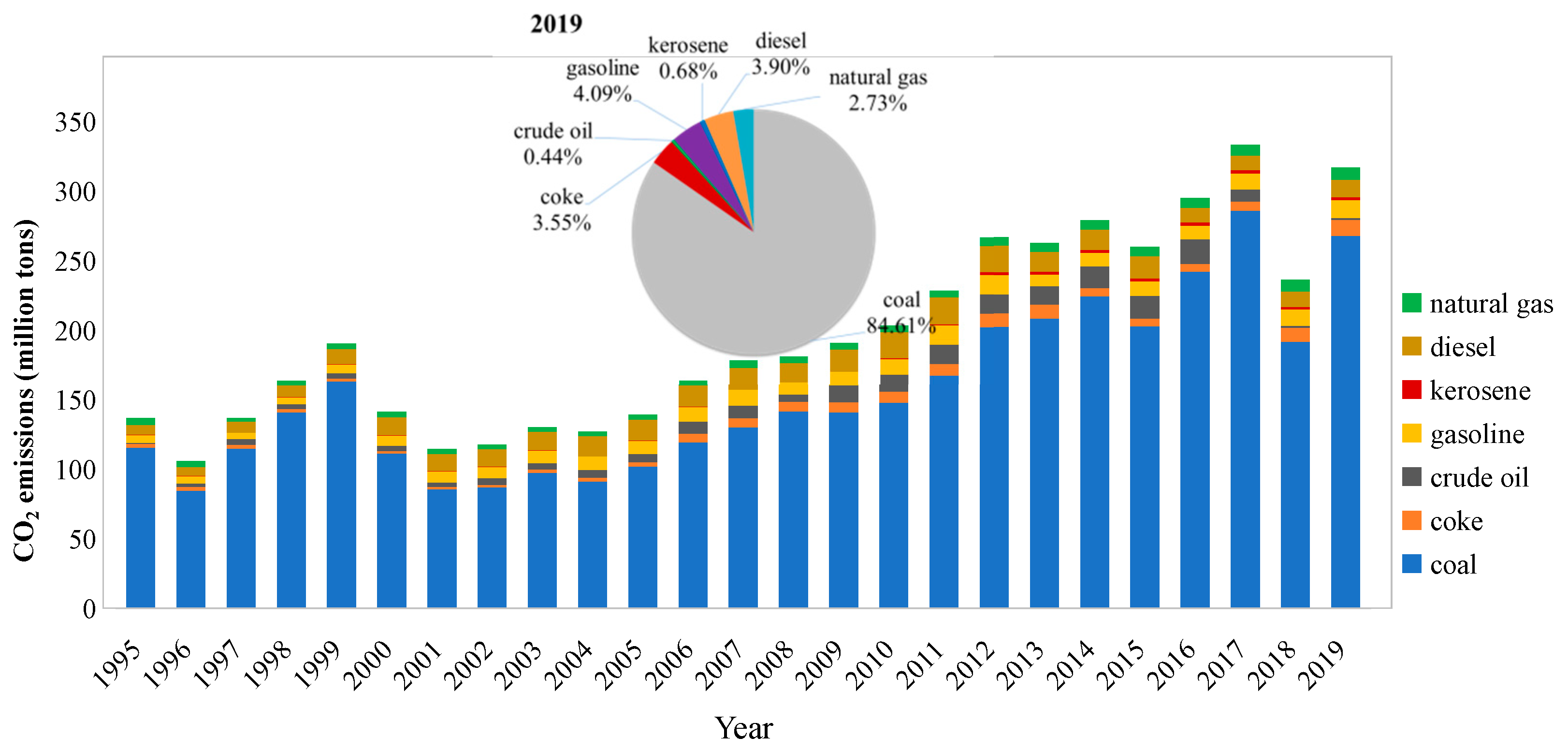
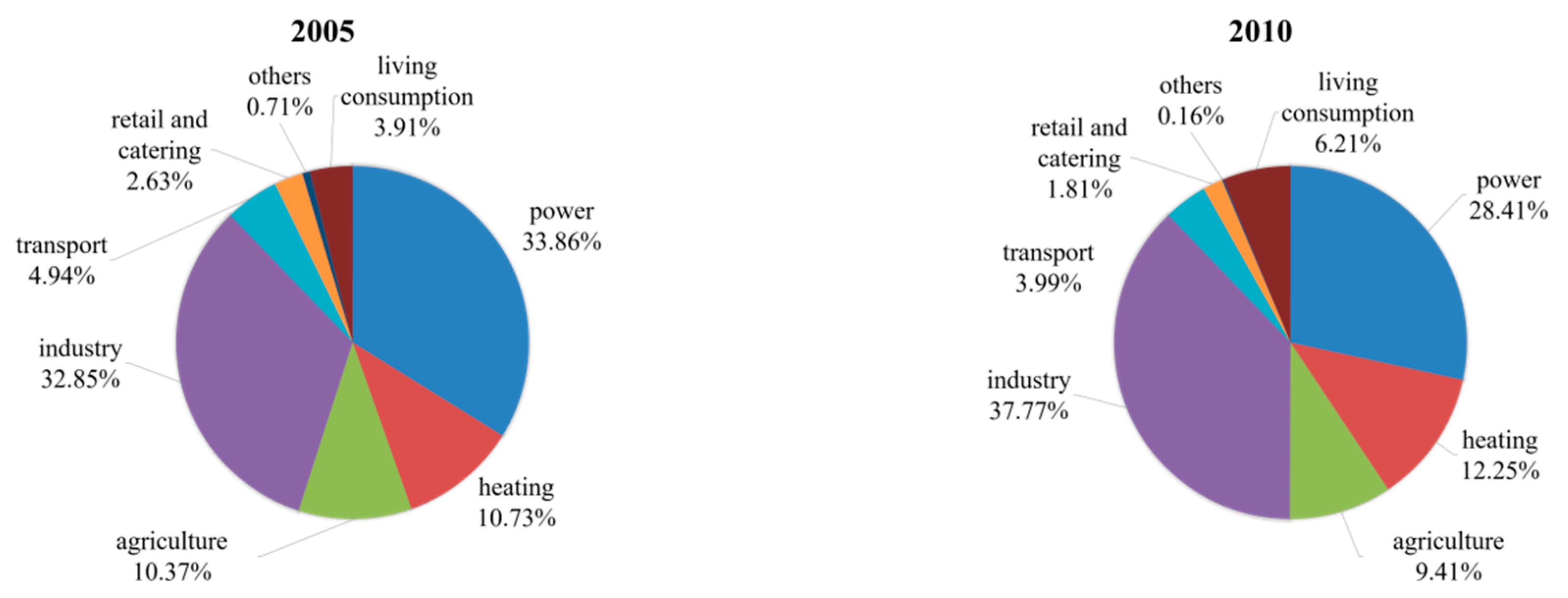

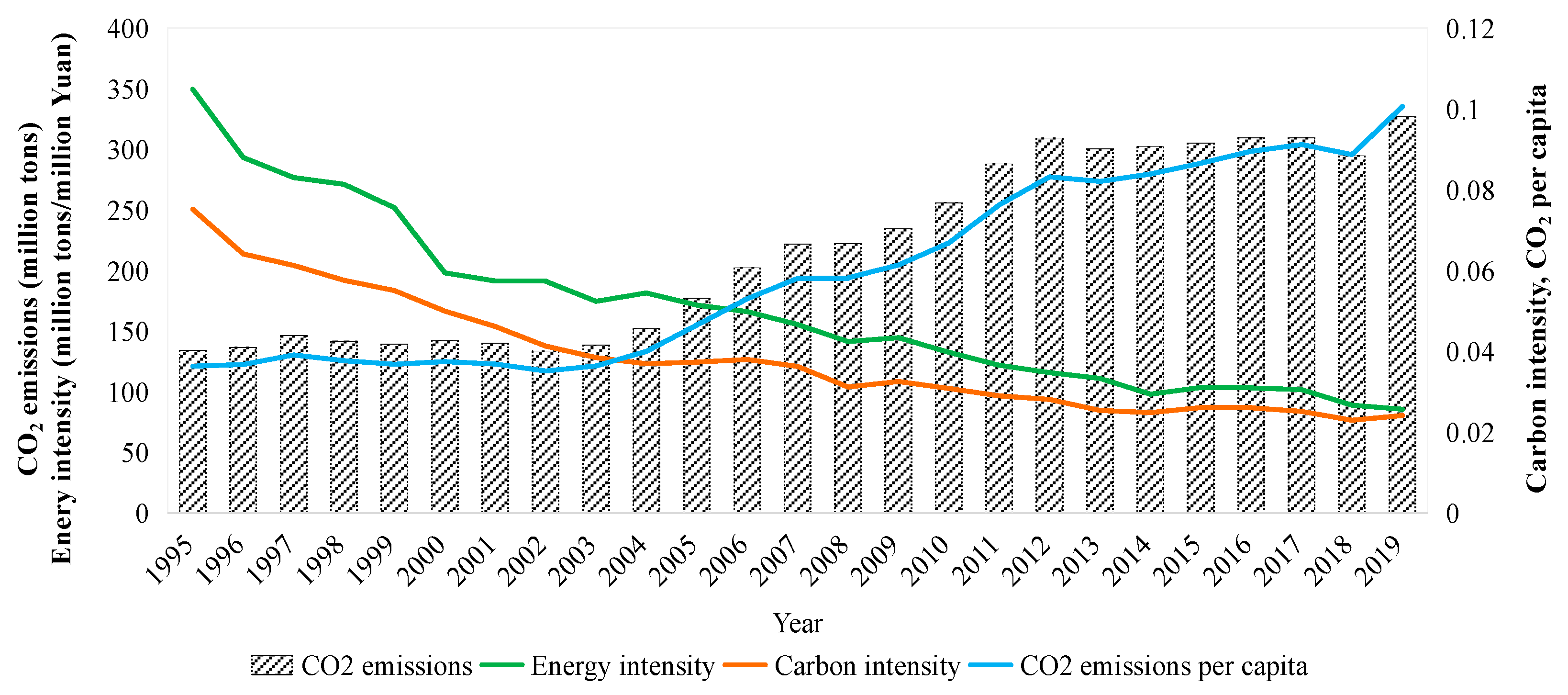
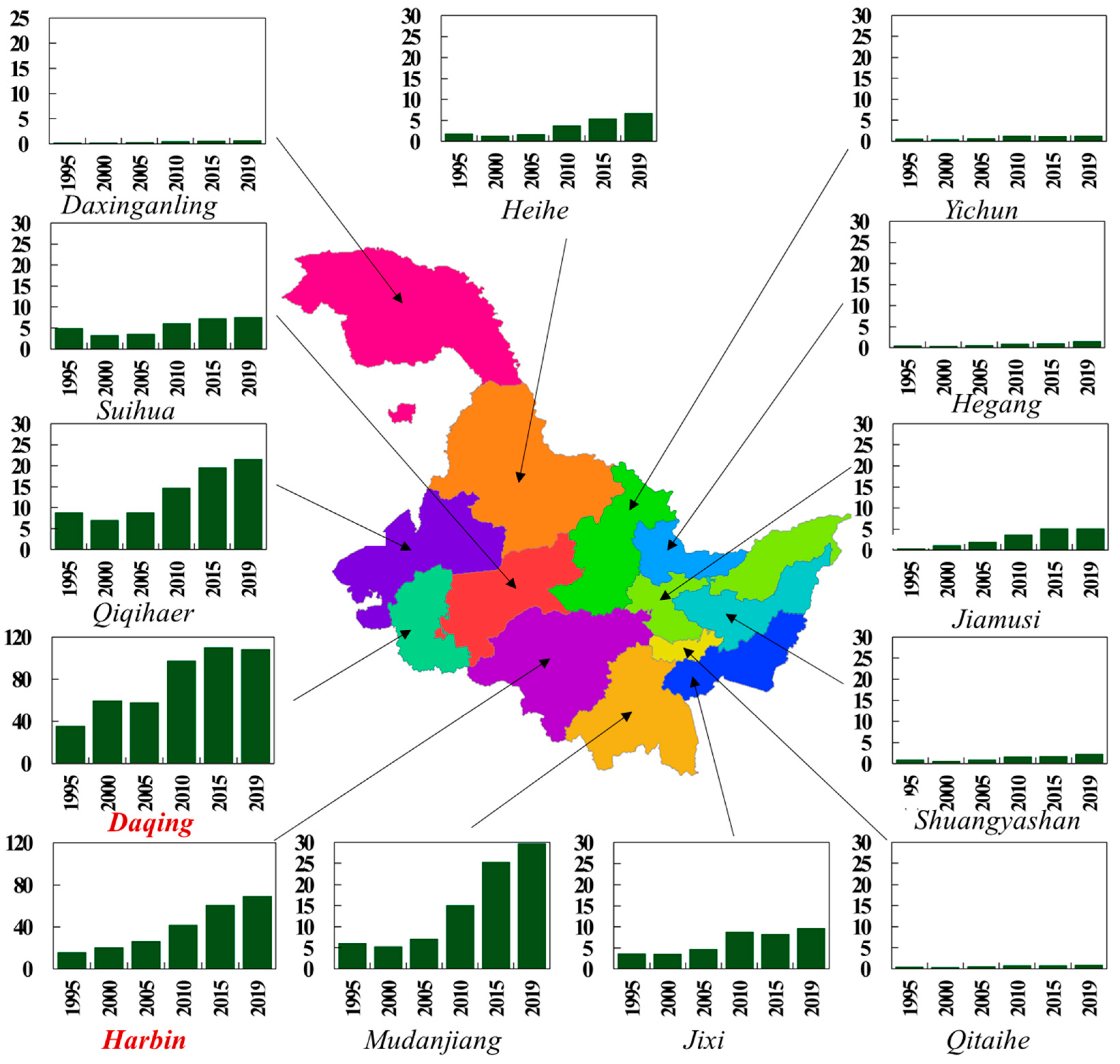
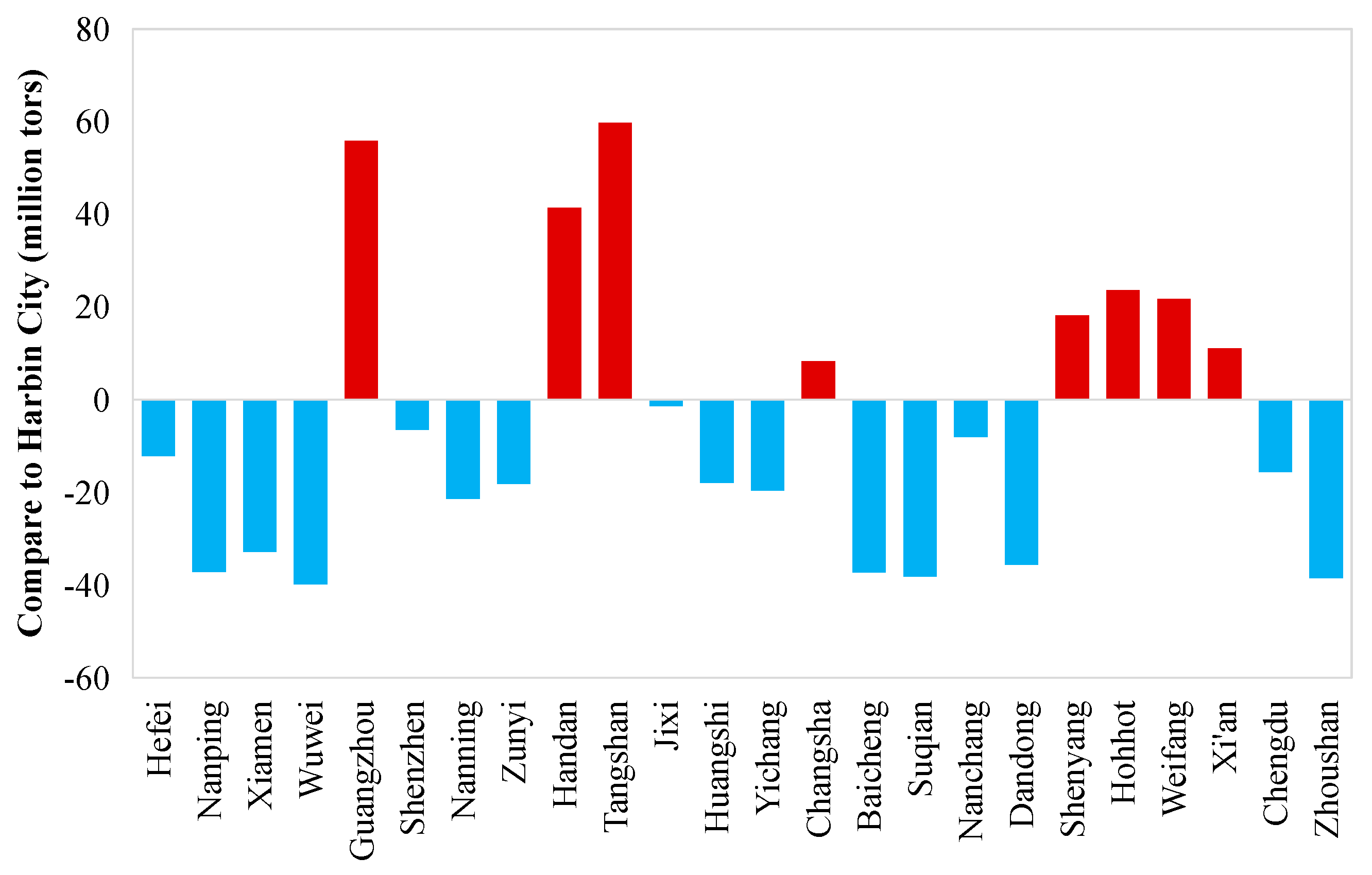
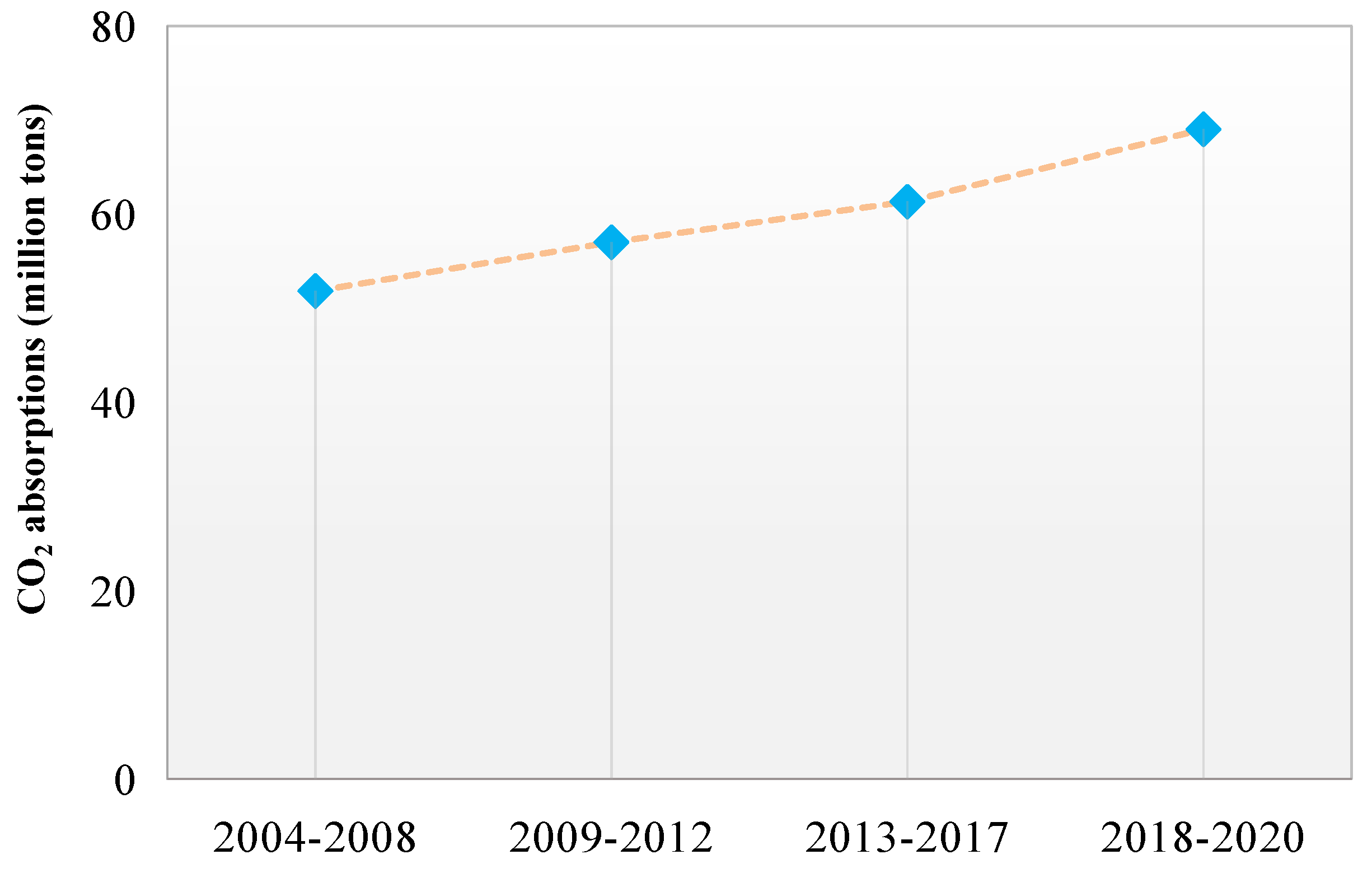
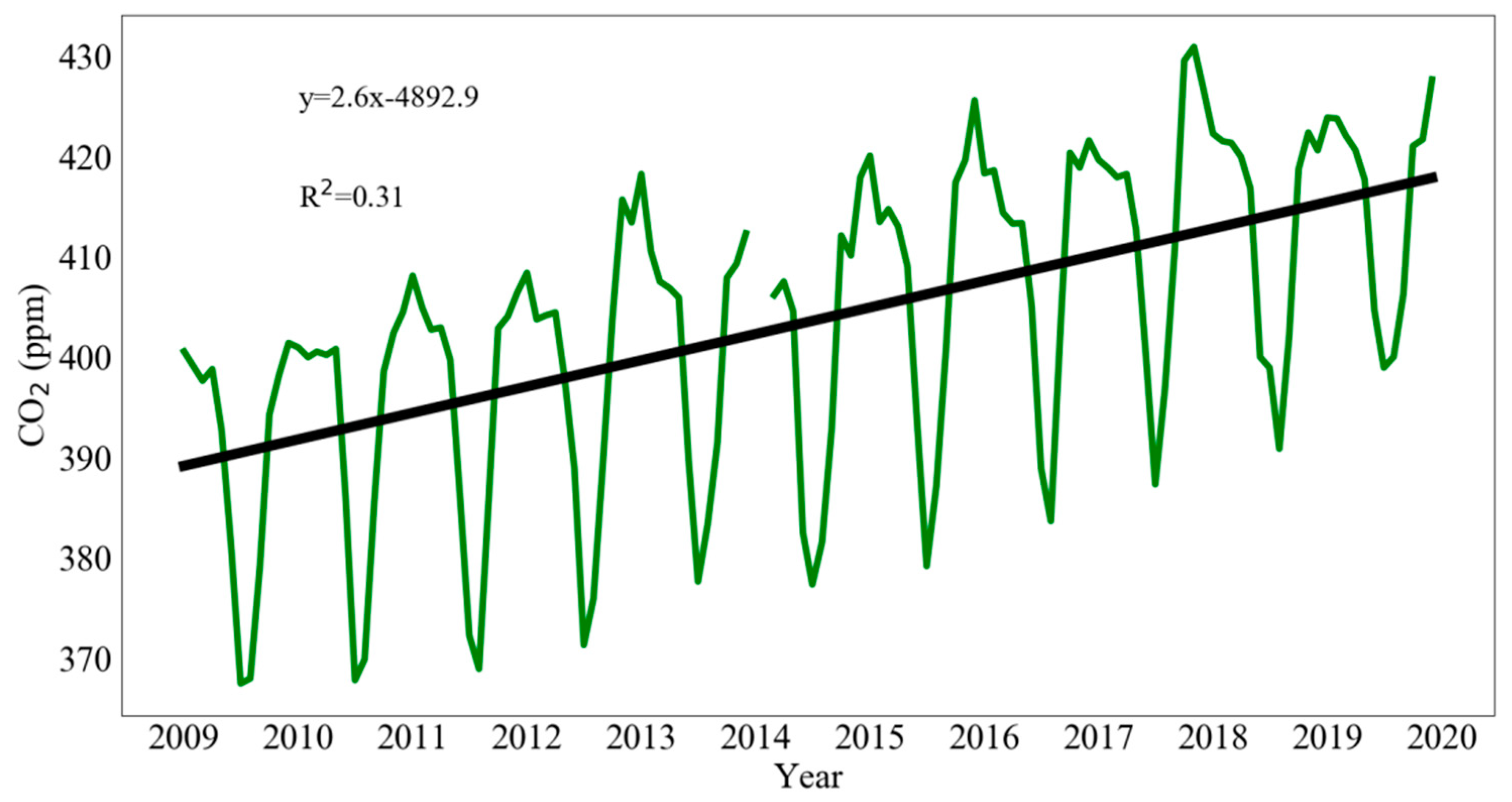
| Sectors | Emission Factors | Units |
|---|---|---|
| Coal | 0.491 [16] | tCO2/ton |
| Oil | 0.838 [16] | tCO2/ton |
| Natural gas | 0.590 [16] | tCO2/thousand m3 |
| Cement | 0.074 [16] | tCO2/ton |
| Iron | 0.04 [8] | tCO2/ton |
| Fertilizer | 0.89 [10,11] | tCO2/ton |
| Pesticide | 4.93 [10,11] | tCO2/ton |
| Farm films | 5.18 [10,11] | tCO2/ton |
| Machinery | 0.18 [10,11] | kg/kW |
| Irritation | 266.48 [10,11] | kg/hm2 |
Disclaimer/Publisher’s Note: The statements, opinions and data contained in all publications are solely those of the individual author(s) and contributor(s) and not of MDPI and/or the editor(s). MDPI and/or the editor(s) disclaim responsibility for any injury to people or property resulting from any ideas, methods, instructions or products referred to in the content. |
© 2023 by the authors. Licensee MDPI, Basel, Switzerland. This article is an open access article distributed under the terms and conditions of the Creative Commons Attribution (CC BY) license (https://creativecommons.org/licenses/by/4.0/).
Share and Cite
Song, W.; Zhu, Z.; Yao, W.; Gao, Z.; Chen, R.; Zhao, Y.; Wang, M.; Wang, X.; Li, C.; Liang, M.; et al. Emissions and Absorption of CO2 in China’s Cold Regions. Processes 2023, 11, 1336. https://doi.org/10.3390/pr11051336
Song W, Zhu Z, Yao W, Gao Z, Chen R, Zhao Y, Wang M, Wang X, Li C, Liang M, et al. Emissions and Absorption of CO2 in China’s Cold Regions. Processes. 2023; 11(5):1336. https://doi.org/10.3390/pr11051336
Chicago/Turabian StyleSong, Weiwei, Zhiyu Zhu, Wanying Yao, Zhi Gao, Ruihan Chen, Yixuan Zhao, Mengying Wang, Xiaoyan Wang, Chunhui Li, Miao Liang, and et al. 2023. "Emissions and Absorption of CO2 in China’s Cold Regions" Processes 11, no. 5: 1336. https://doi.org/10.3390/pr11051336






